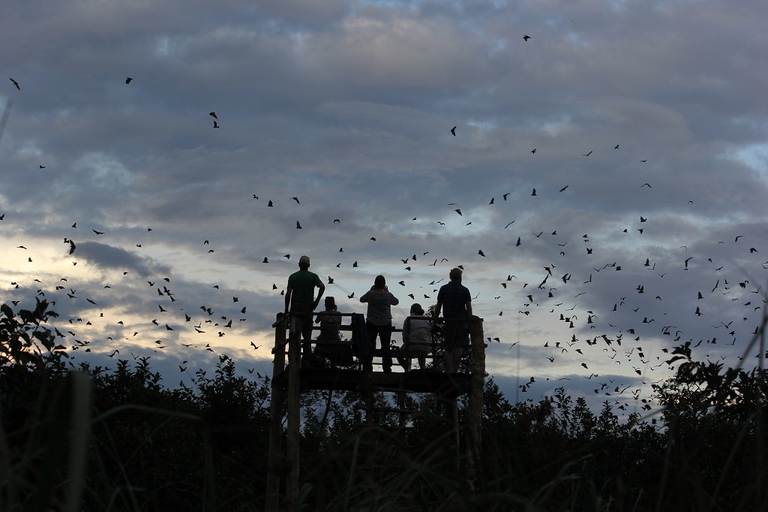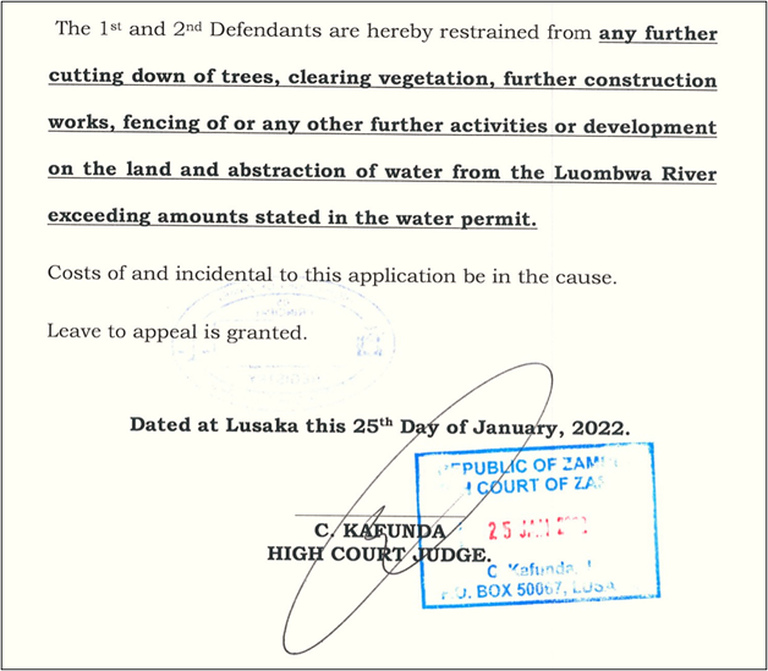
The Copernicus service has released data for the first eleven months of 2025: global warming is set to come close to last year’s record.
Every year, African straw-coloured fruit bats migrate to Kasanka National Park from the Democratic Republic of Congo to pollinate and feed on wild fruits.
The Zambian High Court has imposed an interim injunction on two Tanzania-based businesses, Lake Agro Industries and Gulf Adventures, to put a stop to water extraction, deforestation and commercial agriculture in the Kasanka National Park and its buffer zone (the Kafinda Game Management Area), which are located 521 kilometres northeast of the capital Lusaka. Every year, up to ten million African straw-coloured fruit bats migrate to the wetlands in Kasanka for a few months from the Democratic Republic of Congo. The annual bat migration attracts thousands of tourists, helping to contribute to Zambia’s tourism sector.
Kasanka National Park is one of the most picturesque parks in Zambia and has been designated with the highest level of environmental protection. It contains a rich diversity of animal, bird and plant life. Several rare species are abundant in the park, including African straw-coloured bats, sitatunga, wattled crane, Ross’s Lourie, and the Blue Monkey. Unfortunately, the habitat immediately surrounding the Park, which is critical to the whole ecosystem, is currently being illegally deforested.
Conservationists recently welcomed a high court injunction preventing deforestation and commercial agriculture in the protected area. The activists described the ruling as a positive step forward in protecting the world’s biggest bat migration. “The Park and Game Management Area buffer provides valuable ecosystem services such as water catchment and carbon sequestration, as well as livelihoods reliant on tourism. The protected area is also home to the world’s largest fruit bat migration and impacts here will have a knock-on effect for seed dispersal locally, nationally and beyond the country’s borders”, said Helen Taylor, an ecologist and conservation biologist.
The bats start to arrive in Zambia’s Kasanka National Park between October and December each year, in search of the seed-rich fruits of the sugar plum (Uapaca kirkiana), known locally as Masuku. Having flown from the neighbouring Democratic Republic of Congo, the bats descend into a tiny patch of evergreen swamp-forest, known as mushitu, inside the national park. The giant fruit bats, sometimes also referred to as flying foxes, have straw-coloured bodies and wings that span almost three feet. Now imagine 10 million of these animals (possibly 15 million, according to some researchers): that’s an incredible three metric tonnes of bats converging on a pocket of forest no bigger than two or three football pitches.
The bats also come in search of the water berries, mangoes, wild loquats, and red milkwood berries that are abundant towards the end of the year. This bat species represents one of the most important migratory animals when it comes to regenerating Africa’s forests. Research has shown that each bat will feast on around two kilograms of fruit every night, collectively adding up to around 6,000 tonnes of fruit. The bats then head off on their long migratory path, spreading seeds through their droppings, assisting the growth of new vegetation and ultimately helping the land to regenerate.
The Kasanka Trust, which co-manages the national park alongside the Department of National Parks and Wildlife (DNPW) and two local communities, represented by the Mapepala and Nabowa Community Forest Management Groups, filed an application in court against the destructive and illegal land clearing operations taking place in and around Kasanka National Park. For months, Kasanka Trust and the CFMGs have been embroiled in litigation concerning the actions of Tanzania-based Lake Agro Industries and Gulf Adventures, challenging the legality of their unlawful activities and seeking to put a stop to them.
According to an interim injunction passed by High Court Judge Charles Kafunda, “Lake Agro Industries and Gulf Adventures Ltd are hereby restrained from any further cutting of trees, clearing vegetation, further construction works, fencing of or any other further activities or development on the land and taking of water from the Luombwa river exceeding amounts stated in the water permit by the Water Resource Management Authority (WARMA)”.
James Mwanza, General Manager of Kasanka Trust, said the High Court decision was cause for celebration. “For too long, some of Zambia’s most important habitats, including Kasanka, have been threatened by the illegal activities of private companies, with no consideration of the adverse effect this has had on local communities which depend on the land. The Court’s ruling strengthens our continued efforts to protect the environment,” said Mwanza.
Prior to the approval of an Environmental and Social Impact Assessment (ESIA) by the Zambia Environmental Management Authority (ZEMA), Lake Agro Industries cleared over 560ha of pristine woodland in Kafinda GMA without permission in 2019. Lake Agro Industries proceeded to plant soybean and maize into three of the seven clearings made in the 560-hectare area. The government issued three orders to cease and desist, all of which were ignored. The company proposed to clear a total of 7,000ha of forest from within the GMA and to source water for irrigation from the Luwombwa River, which feeds the wetland habitats of Kasanka National Park and supports local communities.
Aside from the unlawful activities perpetrated by the company, the projects also pose a major threat to the rich biodiversity and water security in the protected area. This further threatens aspirations for Kasanka National Park to be designated as a UNESCO World Heritage Site as host to the largest mammal migration in the world.
Nevertheless, there is yet hope that the current court injunction will put a stop, at least for the time being, to the continued land clearing for agricultural developments and to the removal of water from the rivers that provide the park with life, ensuring its preservation until the case reaches its logical conclusion. The fight to #savekasanka is far from over
Siamo anche su WhatsApp. Segui il canale ufficiale LifeGate per restare aggiornata, aggiornato sulle ultime notizie e sulle nostre attività.
![]()
Quest'opera è distribuita con Licenza Creative Commons Attribuzione - Non commerciale - Non opere derivate 4.0 Internazionale.
The Copernicus service has released data for the first eleven months of 2025: global warming is set to come close to last year’s record.
The European Council and Parliament have reached an agreement on the European Commission’s proposal to deregulate new GMOs. But farming, organic agriculture, and environmental organizations are calling for it to be stopped.
Several hundreds of women in India have rejuvenated vast stretch of forest land through a unique method of guarding the forest.
The solution developed by the Italian startup Agri-E enables on-site bioethanol production, promoting energy self-sufficiency for farms.
South African court dismisses a major lawsuit by 140,000 Zambian women and children against Anglo American for Kabwe lead poisoning. A setback for affected communities enduring the lasting impact of lead contamination.
Controversial African land deals by Blue Carbon face skepticism regarding their environmental impact and doubts about the company’s track record, raising concerns about potential divergence from authentic environmental initiatives.
Majuli, the world’s largest river island in Assam State of India is quickly disappearing into the Brahmaputra river due to soil erosion.
Food imported into the EU aren’t subject to the same production standards as European food. The introduction of mirror clauses would ensure reciprocity while also encouraging the agroecological transition.
Sikkim is a hilly State in north-east India. Surrounded by villages that attracts outsiders thanks to its soothing calmness and natural beauty.











